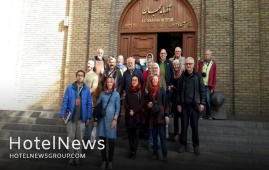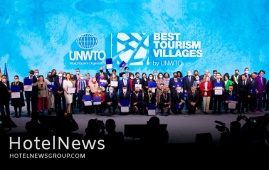
he development of Sistan-Baluchestan through tourism can help the region address its challenges, the deputy tourism chief of the southeastern province has announced. Through the development of tourism, a peace project can be pursued with the neighboring countries in the region, CHTN quoted Mojtaba Mirhosseini as saying on Tuesday. To date, tourism activists in the province have focused on activities for the sustainable development of tourism, which is highly commendable, the official added. The port of Chabahar has the potential to become the maritime tourism capital of Iran, and also the northern region of the province has the potential to become the historical tourism capital of the country, which with the right planning and building of necessary infrastructure, can be achieved, he noted. In order to increase the demand for visiting the province, its attractions and beauty need to be presented as much as possible, he explained. SEO and web marketing are among the most effective digital marketing tools in tourism and can help introduce more people to the province and local businesses, he mentioned. He also noted that organizing fam tours for Iranian tourism activists and media people significantly changed people’s perceptions of the region. Last year, former Cultural Heritage, Tourism, and Handicrafts Minister Ali-Asghar Mounesan said that the development of the travel industry across Sistan-Baluchestan province is among the top priorities for the ministry. “I am interested in Sistan-Baluchestan, and the development of this province is a priority for this ministry and the government,” the former minister stated. “The majority of my travels during my tenure has been to Sistan-Baluchestan, which I consider as a safe province with significant values in terms of culture, history, handicrafts, and tourism.” The collective province -- Sistan in the north and Baluchestan in the south -- accounts for one of the driest regions of Iran with a slight increase in rainfall from east to west, and an obvious rise in humidity in the coastal regions. In ancient times, the region was a crossword of the Indus Valley and the Babylonian civilizations. The province possesses special significance because of being located in a strategic and transit location, especially Chabahar which is the only ocean port in Iran and the best and easiest access route of the middle Asian countries to free waters. The vast province is home to several distinctive archaeological sites and natural attractions, including two UNESCO World Heritage sites, namely Shahr-e-Soukhteh (Burnt City) and Lut desert.
Create: Dec 22, 2021 Edit: Dec 22, 2021 Regional News
The exchange of tourists between Iran and its neighbors is expected to increase in the months to come, Iran’s deputy tourism minister Ali-Asghar Shalbafian has announced. The official made the remarks during a meeting with Hamad Obaidalla the Chief Commercial Officer of Fly Dubai Airlines on Monday. Increasing tourist exchanges with neighboring countries is on the agenda for Iran following the expansion of the flight network between Iran and the United Arab Emirates, he said. To achieve this goal, the private and public sectors will consolidate their capacities, the official added. For his part, Obaidalla said that currently, Fly Dubai Airlines operates 30 flights a week to Iran, and this capacity will grow to nearly 50 flights in the future. By relying on this capability, tourists can be directed to Iranian tourist destinations effectively, he added. Communication between the private sector of the two countries plays a crucial role in achieving executive strategies, he noted. Back in September, Cultural Heritage, Tourism, and Handicrafts Minister Ezzatollah Zarghami announced the issuance of tourist visas and the flow of foreign tourists to Iran would resume as per President Ebrahim Raisi’s order following 19 months of suspension. Currently, tourist visas are once again being issued to cultivate good grounds of hope for travel insiders. However, months of steep recession have taken its toll. Many travel insiders, hoteliers, and tour operators have faced big dilemmas such as bankruptcy, unemployment, debts, and the prospects of not being competitive on the international level. Only months into the outbreak, Zarghami’s predecessor, Ali-Asghar Mounesan, lamented that the number of foreign travelers to Iran was drastically plunged due to the pandemic. “Tourism of the country was growing before the corona [outbreak], its revenues reached $11.7 billion in 2019, which accounted for 2.8% of GDP, nearing the average share of tourism in the world GDP, which was 3.2 percent,” Mounesan said. He added 8.7 million foreign nationals visited Iran during the [Iranian] year (1398), adding that Iran was ranked as the second fastest-growing country in tourism based on data compiled by the World Tourism Organization. The average of international travels to and from Iran fell by 80 percent during the past Iranian calendar year 1399 (ended on March 20, 2021) from a year earlier caused by various coronavirus restrictions. Optimistic forecasts, expect the country would achieve a tourism boom after coronavirus is contained, believing its impact would be temporary and short-lived for a country that ranked the third fastest-growing tourism destination in 2019. UNWTO’s Panel of Experts foresees a rebound in international tourism in the current year, mostly in the third quarter. However, some experts suggest the rebound could occur only in 2022. The Islamic Republic expects to reap a bonanza from its numerous tourist spots such as bazaars, museums, mosques, bridges, bathhouses, madrasas, mausoleums, churches, towers, and mansions, of which 26 are inscribed on the UNESCO World Heritage list. Under the 2025 Tourism Vision Plan, Iran aims to increase the number of tourist arrivals from 4.8 million in 2014 to 20 million in 2025.
Create: Dec 20, 2021 Edit: Dec 22, 2021 Regional News
Hotels have been around for as long as we can remember, but where in history is the origin of this core sector of the tourism industry? While it might come as a surprise for many, the three oldest hotels in the world are all located in Japan and have been operating for hundreds of years. While Japan can boast this very interesting fact, the real champion of historic accommodation facilities is Europe with a large variety of old hotels. In this context, Tourism Review presents the top 10 oldest hotels on the Old Continent – each country represented by only one hotel. Hôtel Cour du Corbeau (France), est. 1528 Located in the heart of Strasbourg and a stone's throw from the cathedral, the Cour du Corbeau is one of the oldest hotels in Europe, being in operation since the beginning of the 16th century. At the same time, it is also one of the most beautiful architectural ensembles of the Renaissance period. The city-owned hotel offers 63 luxurious rooms to its guest, guaranteeing top-notch comfort and an experience to remember. Hostal dos Reis Católicos (Spain), est. 1499 Owned by the Paradores chain (in the ownership of the Spanish government), the Hostal dos Reis Católicos was built as a royal hospital to accommodate pilgrims traveling to Santiago de Compostela. Today, it continues to welcome visitors from all parts of the world in more than 100 rooms and boasts incredible luxury in the heart of one of Spain’s most important cities. Hotel Damier (Belgium), est. 1398 Located on the Grote Markt square in Kortrijk, Damier boasts an impressive history. The first mention of the hotel dates back to the 14th century, with the building boasting an astonishing Rococo façade from 1769. Today, the hotel offers 65 luxurious rooms that will certainly impress even the more demanding individuals. Hotel De Draak (Netherlands), est. 1397 Founded in 1397 and located in the historic center of Bergen op Zoom, Hotel de Draak is the oldest hotel in the Netherlands. It is possible that the hotel is even older, but a huge fire destroyed the city archives in the same year. It is currently owned by the Hazen family and boasts an impressive 62 rooms which provide the guests with fine comfort and luxury. Zum Roten Baeren (Germany), est. 1387 Labelled as the oldest hotel in Germany, the first mention of the Zum Roten Baeren hotel in Freiburg dates to 1387, with the building itself being one of the oldest ones in the city. The guesthouse has been a social center of the city for years and today it has 25 rooms, 20 employees and the ambition to appeal more to the public with its historic charm. Hotel-Gasthof Löwen (Lichtenstein), est. 1380 The Löwen has been offering its services in the hospitality industry since 1380, thus being the oldest hotel in the country. Today the hotel offers elegantly furnished rooms, organization of events and conferences and provides its guests with a gastronomic experience in the form of a restaurant to top it all off. Gastagwirt (Austria), est. 1380 The family led Gastagwirt hotel has been firmly rooted in Eugendorf, in the Salzburg region, for over 700 years. As early as 1380, the "irrevocable, indispensable and forever hereditary liquor license" was awarded to the guesthouse with a letter and a seal. In the present day, the hotel provides fine accommodation services, but especially some of the best seminar and meeting services and facilities in the country. Hotel Interlaken (Switzerland), est. 1323 Hotel Interlaken in Switzerland is also among the oldest hotels in Europe. It was opened in 1323 and was initially meant to be a guesthouse for visitors of the local monastery, while later it was a part of the administration of the region. Today, the family led hotel offers 55 rooms, event organization and much more in the heart of Switzerland. Hotel Alte Goste (Italy), est. 1142 The Alte Goste hotel has been in operation since the 13th century, although the first innkeeper known by name was Gild Stainer in 1557. The region itself served as one of the most important connections between the Holy Roman Empire and Italy. Today the hotel offers a large variety of rooms and apartments for a carefree stay in the Puster Valley. The Olde Bell Hotel (UK), est. 1135 The Olde Bell, located in the small town of Hurley in England first opened almost 900 years ago in 1135. Initially, it operated as a guesthouse for visitors to the nearby Benedictine Priory, but throughout the time it gained even more importance up to the point when Winston Churchill and Dwight D. Eisenhower met there during World War II. Today the hotel offers 48 rooms that guarantee the guests a historic experience not to be forgotten.
Create: Dec 16, 2021 Edit: Dec 16, 2021 International News
The northwestern Iranian province of East Azarbaijan plans to host a delegation of Turkish journalists and media personnel for a familiarization tour across the province in the near future, the provincial tourism chief has announced. A fam tour introducing East Azarbaijan’s tourism capabilities will be organized in cooperation with the private sector during the winter for Turkish media representatives and tourism activists, Ahmad Hamzezadeh said on Monday. A suitable platform can be provided for the development of the tourism industry by having fam tours in the province and taking advantage of the existing capacities in the sector, he explained. Holding fam tours is the best strategy for developing tourism in top countries, the official added. To accomplish this goal, the province’s tourism department is planning to organize fam tours for tourism activists and media members of the other neighboring countries early next year, he noted. Soaked in history and culture for millennia, Tabriz, which is the capital of East Azarbaijan, embraces several historical and religious sites, including the Jameh Mosque of Tabriz and Arg of Tabriz, and UNESCO-registered Tabriz Historic Bazaar Complex to name a few. The city became the capital of the Mongol Il-Khan Mahmud Gazan (1295–1304) and his successor. Timur (Tamerlane), a Turkic conqueror, took it in 1392. Some decades later the Kara Koyunlu Turkmen made it their capital, it was when the famous Blue Mosque was built in Tabriz. The city retained its administrative status under the Safavid dynasty until 1548 when Shah Tahmasp I relocated his capital westward to Qazvin. During the next two centuries, Tabriz changed hands several times between Persia and Ottoman Empire. During World War I, the city was temporarily occupied by Turkish and then Soviet troops. The ancient city was declared a world craft city of carpet weaving by the World Craft in 2016. It also bore the title of 2018 Islamic Tourism Capital.
Create: Dec 14, 2021 Edit: Dec 14, 2021 Regional News
Local authorities plan to boost medical tourism in Gachsaran town, southwestern Kohgiluyeh and Boyer-Ahmad province, the provincial tourism chief has said. Infrastructure has been provided in Gachsaran to facilitate the development of health tourism, Majid Safai announced on Saturday. “There is a strong capacity for the development of the tourism industry, especially health tourism, in the city because of the airport and its fast air access to medical facilities and equipment,” the official explained. Citing an example, the official reminded of a special hospital dedicated to mothers and children which offeres quality servives to domestic and foreign patients. During the coronavirus outbreak, 350 foreign tourists received visas to use the medical services provided by the hospital mentioned, he noted. Many domestic experts believe that medical tourism in Iran is a win-win opportunity both for the country and foreign patients, as they are offered affordable yet quality treatment services and the country gains considerable foreign currency. Iran is one of the major destinations for health tourism in the region, and patients with 55 different nationalities, mostly from neighboring countries including Iraq, Kuwait, Bahrain, Qatar, Saudi Arabia, Oman, Pakistan, Afghanistan, Tajikistan, and Turkmenistan are seeking to use Iran’s services and facilities in this field. The Islamic Republic has set its goals to exceed its yearly medical travelers to around 2 million in the Iranian calendar year 1404.
Create: Dec 12, 2021 Edit: Dec 12, 2021 Regional News
Oman has simplified its travel rules for Iranian nationals who want to stay in the sultanate for up to 14 days. “Travelers from the Islamic Republic of Iran to Oman do not require a visa for [up to] 14 days of stay,” the Iranian embassy in Muscat announced on Saturday, ILNA reported. “In addition, those who want to stay for more than 14 days, can apply for a one-month visa at Muscat airport by paying 21 Omani Rials. . . this type of visa can be extended for another month.” Moreover, negative PCR test or vaccination proof is mandatory for travelers, the report said. Earlier this year Oman announced it would drop visa fees for visitors from 103 countries, including Iran, New Zealand, the United States, the United Kingdom, Australia, China, India, and Turkey. Previously, all tourists entering Oman had to apply for a visa online in advance of their visit, and the visa would be valid for either 10 days, at a cost of about $13, or 30 days for $52. In 2019, former tourism minister Ali-Asghar Mounesan and his Omani counterpart Ahmed bin Nasser al-Mahrizi met in Muscat, discussing ways to deepen bilateral ties particularly in the arena of health and medical tourism.
Create: Dec 12, 2021 Edit: Dec 12, 2021 Regional News
Updating the list of countries that are highly affected by the COVID-19 disease, the German authorities have announced that Iran and four other countries will be removed from the high-risk list on Sunday, December 12. The new update of lists has been published by the Robert Koch Institute (RKI), which is Germany’s responsible body for disease prevention and control. According to the announcement, Iran, Armenia, Mongolia, the Philippines, and Romania who have been fully vaccinated or recovered from the COVID-19 will no longer be part of the high-risk list, according to Schengen Visa. Moreover, travelers from the cited countries will also be released from the quarantine requirement. On the other hand, strict entry rules will continue to apply to unvaccinated and unrecovered travelers who reach Germany from one of the countries that are to be removed from the high-risk list. They can enter Germany only for absolutely essential purposes provided that they follow entry rules, such as testing and quarantine requirements, the report said. Furthermore, In regards to Germany’s high-risk list, no new countries have been added to it. Still, the list currently includes Switzerland, Poland, Liechtenstein, and several other EU/Schengen Area countries such as Croatia, Belgium, Greece, Latvia, Lithuania, Austria, Slovakia, Slovenia, Czechia, and Hungary. All travelers from a high-risk area need to fill in a digital entry form. Moreover, those who haven’t been vaccinated or recovered from the virus must stay self-isolated for ten days upon their arrival in Germany. “Travelers who have previously stayed in a high-risk area must have a test, vaccination, or recovery certificate with them and, if a carrier is used, present the proof for the transport,” the authorities explained. Similar to the high-risk list, Germany’s virus variant areas list has also remained unchanged. Currently, the virus variant list includes Botswana, Eswatini, Lesotho Malawi, Mozambique, Namibia, Zimbabwe, and South Africa. Beforehand, the German leaders agreed to impose stricter restrictions to prevent the further spread of the COVID-19 and its new variant.
Create: Dec 12, 2021 Edit: Dec 12, 2021 International News
ed by members of his cabinet, including Energy Minister, Industry, Mining, and Trade Minister, Agriculture Minister, Culture Minister as well as Cooperatives, Labor and Social Welfare Minister. Falak-ol-Aflak is an imposing monument of Sassanids, which dominates the capital city of Khorramabad in western Iran. The unmissable eight-towered monument seems particularly dramatic when floodlit at night, offering picturesque views of its encircling crenelated battlements. Lorestan is a region of raw beauty that an avid nature lover could spend weeks exploring. The region was inhabited by Iranian Indo-European peoples, including the Medes, c. 1000 BC. Cimmerians and Scythians intermittently ruled the region from about 700 to 625 BC. Lorestan was incorporated into the growing Achaemenid Empire in about 540 BC and successively was part of the Seleucid, Parthian, and Sassanid dynasties.
Create: Dec 11, 2021 Edit: Dec 11, 2021 Regional News
The best examples of villages embracing tourism to provide opportunity and drive sustainable development have been celebrated at the World Tourism Organization (UNWTO) General Assembly in Madrid. The Best Tourism Villages by UNWTO initiative was launched to advance the role of tourism in safeguarding rural villages, along with their landscapes, natural and cultural diversity, and their local values and activities, including local gastronomy. A total of 44 villages from 32 countries across the five world regions were granted the recognition in 2021. All of them stand out for their natural and cultural resources as well as for their innovative and transformative actions and commitment to the development of tourism in line with the Sustainable Development Goals (SDGs). The villages were evaluated by an independent Advisory Board based on a set of criteria covering nine areas: - Cultural and Natural Resources - Promotion and Conservation of Cultural Resources - Economic Sustainability - Social Sustainability - Environmental Sustainability - Tourism Potential and Development and Value Chain Integration - Governance and Prioritization of Tourism - Infrastructure and Connectivity - Health, Safety and Security All of the 44 chosen villages scored a total of 80 or more points or more out of a possible 100. Tourism as a driver of rural development and inclusion “Tourism can be a driver of social cohesion and inclusion by promoting a fairer distribution of benefits throughout the territory and empowering local communities,” says UNWTO Secretary-General Zurab Pololikashvili. “This initiative recognizes those villages committed to making tourism a strong driver of their development and wellbeing”. The Best Tourism Villages by UNWTO initiative includes three pillars: The ‘Best Tourism Villages by UNWTO’: Recognizes villages which are an outstanding example of a rural tourism destination with recognized cultural and natural assets, that preserve and promote rural and community-based values, products and lifestyle and have a clear commitment to innovation and sustainability in all its aspects – economic, social and environmental. The ‘Best Tourism Villages by UNWTO’ Upgrade Programme: The Upgrade programme will benefit a number of villages that do not fully meet the criteria to receive the recognition. These villages will receive support from UNWTO and its Partners in improving elements of the areas identified as gaps in the evaluation process. The ‘Best Tourism Villages by UNWTO’ Network: The Network will provide a space for exchanging experiences and good practices, learnings, and opportunities. It will include representatives of the villages recognized as the ‘Best Tourism Village by UNWTO’ , the villages participating in the Upgrade Programme, as well as experts, public and private sector partners engaged in the promotion of tourism for rural development. A total 174 villages were proposed by 75 UNWTO Member States (each Member State could present a maximum of three villages) for the 2021 pilot initiative. Among which 44 were recognized as Best Tourism Villages by UNWTO. Another 20 villages will enter the Upgrade Programme of the Initiative. All 64 villages enter to make part of the UNWTO Best Tourism Villages Network. The next edition will open in February 2022. List of Best Tourism Villages by UNWTO 2021: Bekhovo, Russian Federation Bkassine, Lebanon Bojo, Philippineshe Caspalá, Argentina Castelo Rodrigo, Portugal Cuetzalan del Progreso, Mexico Cumeada, Portugal Gruyères, Switzerland Batu Puteh , Malaysia Kaunertal, Austria Le Morne, Mauritius Lekunberri, Spain Maní, Mexico Misfat Al Abriyeen, Oman Miyama, Japan Mokra Gora, Serbia Morella, Spain Mustafapaşa, Turkey Nglanggeran, Indonesia Niseko, Japan Nkotsi Village, Rwanda Old Grand Port, Mauritius Olergesailie, Kenya Ollantaytambo, Peru Pano Lefkara, Cyprus Pica, Chile Pochampally, India Puerto Williams, Chile Radovljica, Slovenia Rijal Alma'a, Kingdom of Saudi Arabia Testo Alto, Brazil Saas Fee, Switzerland San Cosme y Damián, Paraguay San Ginesio, Italy Sidi Kaouki, Morocco Solčava, Slovenia Soufli, Greece Taraklı, Turkey The Purple Island, Republic of Korea Ungok Village, Republic of Korea Valposchiavo, Switzerland Wonchi, Ethiopia Xidi, China Yucun, China Additionally, UNWTO will work with the following villages participating in the Upgrade Programme: Ordino, Andorra Khinalig, Azerbaijan Koprivshtitsa, Bulgaria Kaštelir Labinci, Croatia Agros, Cyprus Fuwah, Egypt Western Samos, Greece Hollókő, Hungary Biei, Japan Capulálpam de Méndez, Mexico Godinje, Montenegro Gornja Lastva, Montenegro Oukaimeden, Morocco Barangay Tenani, Philippines Gasura, Rwanda Gostilje, Serbia Gorenja Vas, Slovenia Cantavieja, Spain Bo Suak, Thailand Ruboni, Uganda
Create: Dec 5, 2021 Edit: Dec 5, 2021 International News
The Member States of the World Tourism Organization (UNWTO) have strongly aligned themselves behind its leadership and vision for the sector. Coming together for the 24th General Assembly in Madrid, Spain, Members from every global region approved the Organization’s Programme of Work and endorsed key initiatives designed to build a more a resilient, inclusive and sustainable tourism. The General Assembly has brought together more than 1,000 delegates from 135 countries, including 84 Ministers of Tourism as well as business leaders, destinations and representatives of key international organizations. Opening the General Assembly, UNWTO Secretary-General Zurab Pololikashvili cited the spirit of solidarity and determination that has defined tourism’s response to an unprecedented crisis. In presenting his Report to Members, he made clear how a focus on collaboration and harmonization of protocols, political advocacy and securing financial support for tourism, have help the sector mitigate the impacts of the pandemic and laid the foundations for tourism’s restart in many parts of the country. UN and International Community Backing Mr Pololikashvili said: “In every global region, the pandemic has made clear the importance of our sector – for economic growth, for jobs and trade, and for protecting natural and cultural heritage. We must make the most of this opportunity – to transform goodwill into concrete support.” Emphasizing the significance of the General Assembly, as well as UNWTO’s elevated stature within the global agenda, United Nations Secretary-General Antonio Guterres welcomed delegates and called for them to work together for a “green, inclusive, sustainable” future. Mr Guterres added: “I commend UNWTO and Secretary-General Pololikashvili and hope the decisions taken at the General Assembly will help restore trust in travel and get the world moving safely do developing economies can reap the benefits of sustainable tourism.” The United Nations Secretary-Generals words of support were echoed by the Director-General of the World Health Organization (WHO) Dr Tedros Adhanom Ghebreyesus, by Rebeca Greenspan, Secretary-General, United Nations Conference on Trade and Development (UNCTAD), by Juan Carlos Salazar Gómez, Secretary-General of the International Civil Aviation Organization, and by Vice-President of the European Commission Margaritis Schinas. Alongside receiving an updated on UNWTO’s activities since the last General Assembly two years ago, Members also benefited from a comprehensive overview of the latest tourism trends, as indicated by UNWTO’s latest data, as well as an updated overview of restrictions on travel worldwide. From the floor of the Assembly, Members from different global regions expressed their solidarity with countries impacted by the continued imposition of travel restrictions. Also in Madrid, Member States voted in person to approve the UNWTO Executive Council’s nomination of Mr Pololikashvili to serve as Secretary-General for a second term. On the back of the strongly favorable vote, Mr Pololikashvili will lead UNWTO from 2022 to 2025. UNWTO Again Welcomes Royal Approval On the eve of the General Assembly, His Majesty King Felipe VI of Spain praised UNWTO’s “outstanding work” leading global tourism, most notably over the past 18 months during the worst crisis in the sector’s history. At a special Royal Gala Dinner, His Majesty also emphasized the importance of tourism for economies and societies, both in Spain and globally, making the sector’s recovery essential for many millions of people.
Create: Dec 2, 2021 Edit: Dec 2, 2021 International News
Tourism leaders from every global region have arrived in Madrid for the 24th Session of the UNWTO General Assembly. Ministers of Tourism will be joined by representatives of international organizations and from across the private sector for the first truly global tourism meeting to be held since the start of the pandemic, with innovation, education and investments high on the agenda. In all, more than 1,000 participants, representing 135 countries and including 84 Ministers and Vice-Ministers of Tourism will attend the most important meeting of the United Nations specialized agency for tourism. UNWTO Secretary-General Zurab Pololikashvili said: “Guided by UNWTO, global tourism is facing up to the challenges of today while looking to the opportunities of tomorrow. The UNWTO General Assembly shows the sector’s determination to restart, lead recovery and be a central pillar of sustainable development and climate action.” Towards an International Code for the Protection of Tourists UNWTO opened the General Assembly with an Induction Session for the International Code for the Protection of Tourists. Launched in response to the drop in consumer confidence caused by the pandemic, the landmark legal code will provide minimum standards and consumer rights for tourists in emergency situations. It was developed in collaboration with 98 Member States and Associate Members as well as 5 non-member States international organizations and leading private sector stakeholders. Once adopted by the UNWTO General Assembly, the Code will be presented to the United Nations General Assembly in 2022 with the aim of making it a Resolution. Affiliate Members Meet to Reform and Restart Held within the framework of the General Assembly, UNWTO’s Affiliate Members met today for their 43rd annual Plenary Session. Made up of businesses and destinations, as well as representatives from civil society and academic, UNWTO counts on more than 500 Affiliates to transform tourism policy into action. In Madrid, participants were given an overview of UNWTO’s crisis response, with the Destination Tracker developed by in partnership with the International Air Transport Association (IATA) presented as an example of effective public-private partnerships. At the same time, delegates approved the proposed Reform of the Legal Framework for UNWTO Affiliate Membership, paving the way for more effective collaboration Executive Council Endorses Key Initiatives Ahead of the official opening of the General Assembly, UNWTO convened its Executive Council for a 114th session. The Council, which serves as the governing board of UNWTO, met to hear Secretary-General Pololikashvili present his report on the work done since the 113th session, also held in Madrid at the start of the year. The Members of the Executive Council agreed to the iimplementation of the General Programme of Work for 2020-2021 and for 2022-2023. Members also endorsed several key UNWTO initiatives, notably the UNWTO Recommendations on Tourism for Rural Development, the Best Tourism Villages project and the Global Tourism Plastics Initiative. Also meeting in Madrid, the UNWTO Committees on Tourism and Sustainability, on Tourism and Competitiveness and on Tourism Online Education, brought together experts to explore ways to advance the Organization’s Programme of work around key priority areas.
Create: Dec 1, 2021 Edit: Dec 1, 2021 International News
A group of 10 Iraqi tour operators and travel agents along with their Iranian fellows are to commence a familiarization tour across the northern province of Golestan, the provincial tourism chief has announced. The group will start a four-day familiarization tour on Tuesday with the aim of getting acquainted with the province’s tourism potential as a travel destination, Ahmad Tajari said on Monday, CHTN reported. During the tour, there will be specialized meetings to exchange information and to build a stronger relationship between both sides, the official added. Both sides will also visit tourism, cultural heritage, and handicraft sites to learn more about their capabilities in these areas, he noted. The tour will also highlight the province’s strengths, including its natural, cultural, historical, handcrafts, agricultural tourism, and other assets, he mentioned. The Golestan province, with its ethnic diversity, various climate and potential in handicrafts and cultural heritage, has a very high potential for foreign tourism, and Iraq is one of its important target countries, the official explained. Last week, several Iraqi travel insiders and tour operators requested Iran to waive visa requirements for Iraqi nationals who want to enter the Islamic Republic via land borders. Earlier this year the two neighbors agreed to abolish visa requirements for air travelers. The announcement came after Iranian President Seyyed Ebrahim Raisi and Iraqi Prime Minister Mustafa al-Kadhimi met in Tehran, discussing various issues including visa waiver, a joint railway project, and increasing the level of trade. Before the coronavirus pandemic, Iraqi constituted Iran’s largest source of tourists. In return, hundreds of thousands of Iranian pilgrims head for the holy Iraqi cities of Najaf and Karbala each year to attend the Arbaeen pilgrimage, aka the Arbaeen trek, to mark an end to the 40-day mourning period following the martyrdom of Imam Hussein (AS), the grandson of Prophet Muhammad (PBUH). Golestan is reportedly embracing some 2,500 historical and natural sites, with UNESCO-registered Gonbad-e Qabus – a one-millennium-old brick tower – amongst its most famous. Narratives say the tower has influenced various subsequent designers of tomb towers and other cylindrical commemorative structures both in the region and beyond. The UNESCO comments that the tower bears testimony to the cultural exchange between Central Asian nomads and the ancient civilization of Iran.
Create: Nov 30, 2021 Edit: Nov 30, 2021 Regional News
